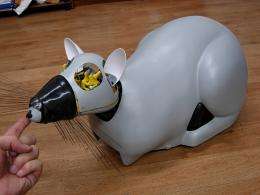The future of robots is rat-shaped

Agnes Guillot dreams of one day seeing a giant 50-centimetre (20-inch) -long white rat called Psikharpax scuttling fearlessly around her lab.
If so, it will be time to scream... but out of joy, rather than fear, for it could be a turning point in the history of robotics.
Psikharpax -- named after a cunning king of the rats, according to a tale attributed to Homer -- is the brainchild of European researchers who believe it may push back a frontier in artificial intelligence.
Scientists have strived for decades to make a robot that can do some more than make repetitive, programmed gestures. These are fine for making cars or amusing small children, but are of little help in the real world.
One of the biggest obstacles is learning ability. Without the smarts to figure out dangers and opportunities, a robot is helpless without human intervention.
"The autonomy of robots today is similar to that of an insect," snorts Guillot, a researcher at France's Institute for Intelligent Systems and Robotics (ISIR), one of the "Psikharpax" team.
Such failures mean it is time to change tack, argue some roboticist.
Rather than try to replicate human intelligence, in all its furious complexities and higher levels of language and reasoning, it would be better to start at the bottom and figure out simpler abilities that humans share with other animals, they say.
These include navigating, seeking food and avoiding dangers.
And, for this job, there can be no better inspiration than the rat, which has lived cheek-by-whisker with humans since Homo sapiens took his first steps.
"The rat is the animal that scientists know best, and the structure of its brain is similar to that of humans," says Steve Nguyen, a doctoral student at ISIR, who helped show off Psikharpax at a research and innovation fair in Paris last week.
Rat robots are being built in other labs in Britain, the United States and elsewhere. Two years ago, for instance, a team at the ITAM technical institute in Mexico City reprogrammed a Sony Aibo dog using rat-simulated sofware.
But the European researchers believe that Psikharpax is unique in its biomimickry, sophistication of sensors and controls and software based on rat neurology.
Their artificial rodent has two cameras for eyes, two microphones for ears and tiny wheels, driven by a battery-powered motor, to provide movement.
A couple of dozen whiskers measuring around a dozen centimetres (four inches) stretch out impressively either side of its long, pointed snout.
The patented "vibrissae" seek to replicate a key part of the nervous system in a real-life rat, where whiskers are used to sense obstacles.
Data from these artificial organs goes to Psikharpax's "brain," a chip whose software hierarchy mimicks the structures in a rat's brain that process and analyse what is seen, heard and sensed.
For instance, if Psikharpax's eyes sense that it is dark, the software gives a greater weight of importance to data from the whiskers, in the same way that a rat, at night, relies on other sensors to compensate for loss of vision.
But one famous rat quality -- the power of smell -- is not incorporated in Psikharpax. An artificial nose was originally included in the scheme, conceived by roboticist Jean-Arcady Meyer, but proved too complex in practice.
The goal is to get Psikharpax to be able to "survive" in new environments. It would be able to spot and move around things in its way, detect when it is in danger from collision with a human in its vicinity and spot an opportunity for "feeding" -- recharging its battery at power points placed around the lab.
"We want to make robots that are able to look after themselves and depend on humans as least as possible," said Guillot.
"If we want to send a robot to Mars, or help someone in a flat that we don't know, the robot has to have the ability to figure out things out for itself."
(c) 2009 AFP


















